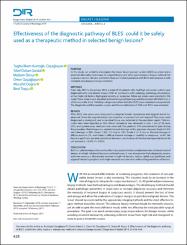| dc.contributor.author | Kurtoğlu Özçağlayan, Tuğba İlkem | |
| dc.contributor.author | Gürdal, Sibel Özkan | |
| dc.contributor.author | Öznur, Meltem | |
| dc.contributor.author | Özçağlayan, Ömer | |
| dc.contributor.author | Doğru, Mücahit | |
| dc.contributor.author | Topçu, Birol | |
| dc.date.accessioned | 2022-05-11T14:07:44Z | |
| dc.date.available | 2022-05-11T14:07:44Z | |
| dc.date.issued | 2019 | |
| dc.identifier.issn | 1305-3612 | |
| dc.identifier.uri | https://doi.org/10.5152/dir.2019.18427 | |
| dc.identifier.uri | https://hdl.handle.net/20.500.11776/5186 | |
| dc.description.abstract | PURPOSE In this study, we aimed to investigate the breast lesion excision system (BLES) as a tool and a practical alternative technique to surgical biopsy and other percutaneous biopsy methods for spicious lesions. We also wanted to share our initial experience with BLES and compare it with standard percutaneous biopsy methods. METHODS From July 2015 to December 2016, a total of 50 patients who had high-risk lesions which were diagnosed with core needle biopsy (CNB) or had lesions with radiology pathology discordance, or had high-risk factors, high-grade anxiety, or suspicious follow-up lesions were enrolled in the study.These lesions were classified as Breast Imaging Reporting and Data System (BI-BADS) 3 or 4, which are under 2 cm. Pathologic diagnoses before and after BLES were evaluated comparatively. The diagnostic and therapeutic success and the complications of CNB and BLES were analyzed. RESULTS After BLES, two cases were diagnosed as atypical lobular hyperplasia and atypical ductal hyperplasia. Since the surgical margin was negative, re-excision was not required. Two cases were diagnosed as malignant, and no residual tissue was detected in the operation region. Total excision rates were reported as 56%. Minor hematoma was observed in only 1 out of 50 cases (2%), and spontaneous remission was observed. Two patients (4%) complained of pain during the procedure. Radiofrequency-related thermal damage to the specimen showed: Grade 0 (<0.5 mm) damage in 88%, Grade 1 (0.5-1.5 mm) in 10%, Grade 2 (>1.5 mm or thermal damage in diffuse areas) in 2%, and Grade 3 (diffuse thermal damage or inability to diagnose) in 0%. We found a significant positive correlation between classification of thermal damage and lesion fat cell content (r = 0.345, P = 0.015). CONCLUSION BLES is a safe technique that can be effectively used with low complication rates in the excision of benign and high-risk breast lesions in selected cases. It may also provide high diagnostic success and even serve as a therapeutic method in high-risk lesions, such as radial scar, papilloma, and atypical lobular hyperplasia with high complete excision rates without fragmentation of lesions. | en_US |
| dc.language.iso | eng | en_US |
| dc.publisher | Turkish Soc Radiology | en_US |
| dc.identifier.doi | 10.5152/dir.2019.18427 | |
| dc.rights | info:eu-repo/semantics/openAccess | en_US |
| dc.subject | Excision System Bles | en_US |
| dc.subject | Nonpalpable Breast-Lesions | en_US |
| dc.subject | Biopsy | en_US |
| dc.subject | Specimen | en_US |
| dc.subject | Radiofrequency | en_US |
| dc.subject | Device | en_US |
| dc.subject | Risk | en_US |
| dc.title | Effectiveness of the diagnostic pathway of BLES: could it be safely used as a therapeutic method in selected benign Lesions? | en_US |
| dc.type | article | en_US |
| dc.relation.ispartof | Diagnostic and Interventional Radiology | en_US |
| dc.department | Fakülteler, Tıp Fakültesi, Dahili Tıp Bilimleri Bölümü, Radyoloji Ana Bilim Dalı | en_US |
| dc.department | Fakülteler, Tıp Fakültesi, Cerrahi Tıp Bilimleri Bölümü, Genel Cerrahi Ana Bilim Dalı | en_US |
| dc.department | Fakülteler, Tıp Fakültesi, Cerrahi Tıp Bilimleri Bölümü, Tıbbi Patoloji Ana Bilim Dalı | en_US |
| dc.department | Fakülteler, Tıp Fakültesi, Temel Tıp Bilimleri Bölümü, Biyoistatistik Ana Bilim Dalı | en_US |
| dc.authorid | 0000-0002-6396-3168 | |
| dc.identifier.volume | 25 | en_US |
| dc.identifier.issue | 6 | en_US |
| dc.identifier.startpage | 428 | en_US |
| dc.identifier.endpage | 434 | en_US |
| dc.institutionauthor | Kurtoğlu Özçağlayan, Tuğba İlkem | |
| dc.institutionauthor | Gürdal, Sibel Özkan | |
| dc.institutionauthor | Öznur, Meltem | |
| dc.institutionauthor | Özçağlayan, Ömer | |
| dc.institutionauthor | Doğru, Mücahit | |
| dc.institutionauthor | Topçu, Birol | |
| dc.relation.publicationcategory | Makale - Uluslararası Hakemli Dergi - Kurum Öğretim Elemanı | en_US |
| dc.authorscopusid | 56085483700 | |
| dc.authorscopusid | 8204207500 | |
| dc.authorscopusid | 15844109600 | |
| dc.authorscopusid | 56084894100 | |
| dc.authorscopusid | 55915823300 | |
| dc.authorscopusid | 37058172000 | |
| dc.authorwosid | Gurdal, Sibel Ozkan/ABA-3882-2020 | |
| dc.authorwosid | ÖZÇAĞLAYAN, ÖMER/ABA-4293-2020 | |
| dc.authorwosid | Ozcaglayan, Tugba İlkem Kurtoglu/ABA-4247-2020 | |
| dc.identifier.wos | WOS:000495398900003 | en_US |
| dc.identifier.scopus | 2-s2.0-85074552605 | en_US |
| dc.identifier.pmid | 31650964 | en_US |



















